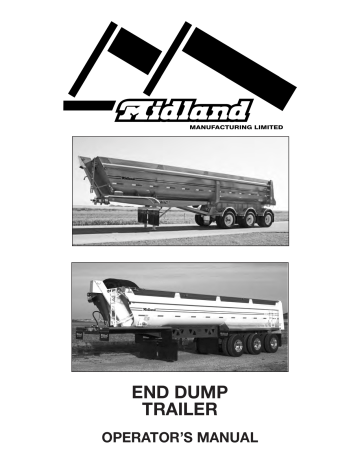advertisement

2.4 UNLOADING SAFETY
1. Do not load trailer in excess of the gross vehicle weight rating shown on the certification plate.
2. Do not load unevenly. Load must be evenly distributed during loading and dumping. Wet, frozen, or sticky loads may hang up and cause trailer to upset.
3. Do not attempt to dump loads in high wind conditions.
4. Do not raise body where overhead obstructions may exist. Be especially alert for power line obstructions.
5. Do not move trailer unless body is in fully lowered position.
6. Do not allow persons or equipment to enter area where they might be endangered if trailer should upset while dumping.
7. Do not attempt, under any conditions, to work on or service trailer with the body in a raised position, unless body is empty and is properly braced and propped so that it cannot fall.
8. Do not park trailer with body in a raised position.
9. Do not use the cylinder as a stabilizer during the dump cycle. The cylinder is strictly a lifting device and is not a structural member of the dumping unit.
10. Do not jerk, or slingshot dump unit in an attempt to free a sticking or frozen load.
11. Have tractor and trailer in a straight line on FIRM,
LEVEL ground with all tires in contact with the ground when dumping. VERY IMPORTANT (on triaxle end dumps - all axles must be on solid footing before dumping).
12. Have tractor and trailer securely braked before using hoist except for 1/4 Frame End Dump; where the tractor only or the trailer only must be securely braked.
13. Release tailgate before starting dump cycle and only after ensuring that nobody is anywhere near the rear of the trailer.
14. Stay at controls while dumping or lowering body.
Lower body immediately if shifting or leaning occurs during dump cycle.
15. Feather the dump unit down slowly to avoid a high-pressure build up in the cylinder when lowering a load that is sticking.
16. Inspect trailer to assure safe operation as often as a prudent person would deem necessary but in no case less than daily when in operation.
2.5 TRAVEL SAFETY
1. Read and understand all the information in the operator’s manual regarding procedures and safety when operating the Trailer unit in the field or on the road.
2. Make sure all the lights and reflectors that are required by the local highway and transport authorities are in place, are clean and can be seen clearly by all overtaking and oncoming traffic.
3. Drive carefully and defensively at all times and especially when negotiating uneven or hilly terrain.
4. Do not allow riders on any part of the trailer unit(s).
5. Make sure you are in compliance with all local regulations regarding transporting on public roads and highways. Consult your local law enforcement agency for further details.
5
advertisement
Related manuals
advertisement
Table of contents
- 13 1 Introduction
- 14 Safety
- 15 General Safety
- 16 Operating Safety
- 16 Maintenance Safety
- 17 Unloading Safety
- 17 Travel Safety
- 18 Loading Safety
- 18 Tire Safety
- 18 Safety Signs/Decals
- 19 Sign-Off Form
- 20 Safety Sign (Decal) Locations
- 24 Operation Guidelines
- 24 To the New Operator or Owner
- 25 Terminology
- 26 Break-In
- 28 Controls
- 32 Pre-Operation Vehicle Inspection Procedure
- 35 Hooking Up/Unhooking
- 35 Hooking Up
- 37 Unhooking
- 38 End Gate
- 39 Lift Cylinder
- 40 Air System
- 40 Gate Latch Control System
- 41 Tanks
- 42 Loading/Unloading
- 47 Transporting
- 47 Operating Instructions
- 48 Braking Guidelines
- 49 Tires
- 50 Optional Equipment
- 51 Service and Maintenance
- 51 5.1 Service
- 51 Fluids and Lubricants
- 51 Greasing
- 53 Servicing Intervals
- 65 Service Record Summary (Lubrication)
- 66 Periodic Maintenance and Adjustments
- 66 Torque Specification Summary
- 68 Kingpin and Anchor Frame
- 69 Axle Alignment
- 71 Wheel Hubs/Bearings
- 75 Wheels
- 77 Tires
- 79 Brakes
- 82 Slack Adjusters
- 82 Automatic Slack Adjuster
- 83 Automatic Slack Adjuster Maintenance
- 89 Air Chamber/Spring Brake
- 90 Trailer ABS
- 91 Suspension System
- 91 Air Ride Suspension
- 95 Spring Ride Suspension
- 97 Air System
- 97 Air System Inspection
- 97 Air System Functional
- 98 Electrical System
- 99 Trouble Shooting
- 107 Bolt Torque